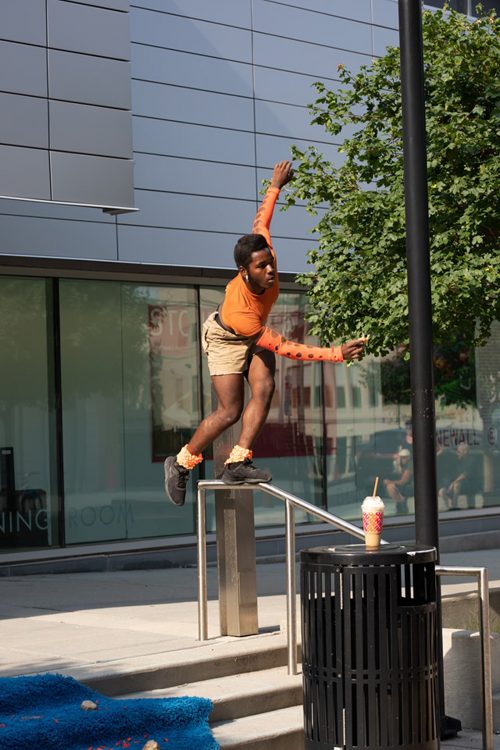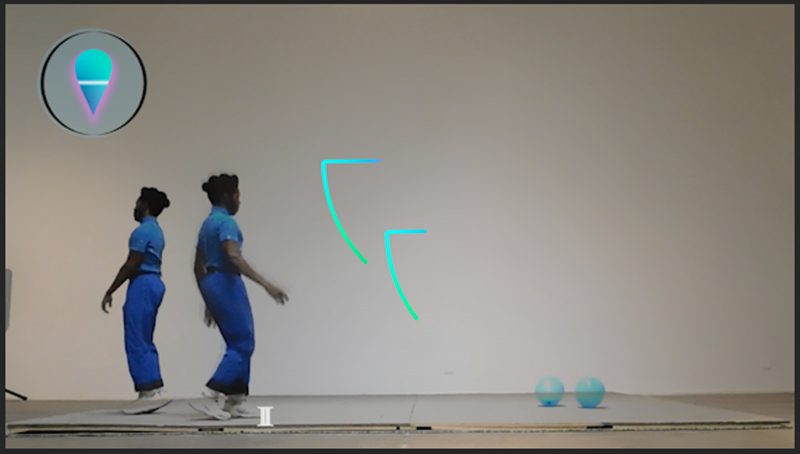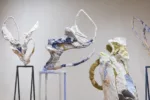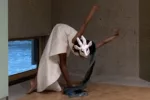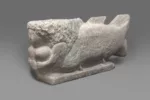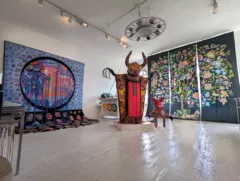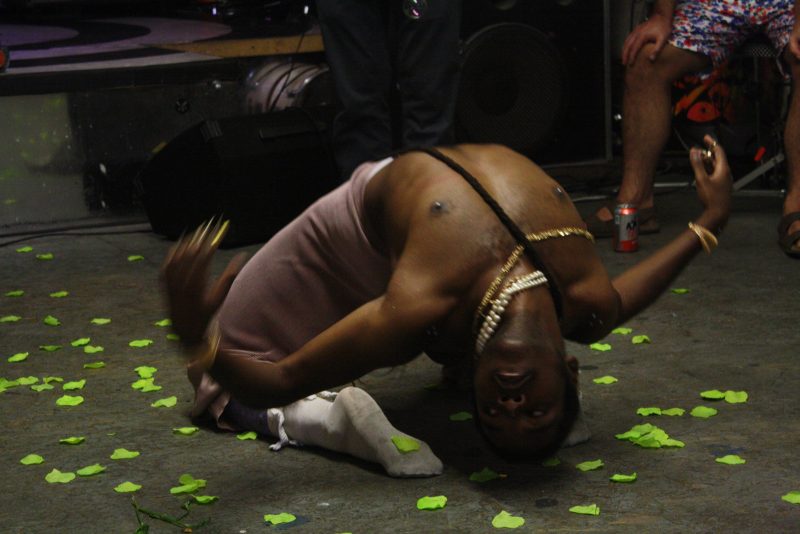
There’s a magnetic tension that wells up within witnesses to Vitche-Boul Ra dances, the viewer’s consciousness transported by a ritual that feels ethereal yet strangely earthbound. As Ra moves across the space– be it a taste-making, traditional artspace like Fishtown’s Icebox Project Space, or a batting-cage-turned-DIY-performance art space like Everybody Hits– the viewer can practically see the dust kicked up under Ra’s feet, can taste the earth itself, as the dancer’s movements both repels with sharp, determined line work and invites with the same magic. It’s a dizzying journey; Ra at one moment careens like an Alvin Ailey dancer at a Vodun ceremony, the next a balletic voguer on a makeshift runway, and within the next he’s asking the audience to join in the performance, often handing out props or talismans with instructions, imploring– daring– a cognizant rapport with his work, with dance in general.
It’s this flowering multiplicity and immersive intersectionality that belies the ritual nature of Ra’s work. In fact, the dancer downplays those aspects. “Recently I’ve replaced the idea that the work is ritual or spiritual with the idea that the work plainly hinges on formlessness, beauties, and destructive activations,” Ra says.
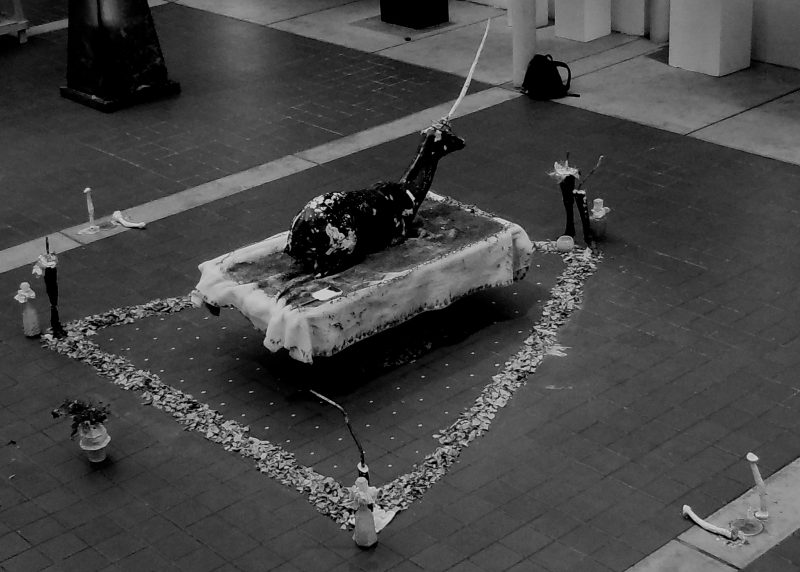
“Something about naming ritual and spiritual so clearly gets me caught up in things that barely serve the work or just get very boring, very quickly. However, my practice is built around utilizing my body as a vessel or passage point and harnessing an energy, a truth, to cast into space. Typically repetitions and replications of texts, movement patterns, and sounds are used for loading and casting. The images, wards, signals, beacons that appear are often used as secondary passages and keys that bring the energy closer to the space, ultimately allowing it to sit and deliver its mark and intention.”
As tension builds in his pieces, like “Spatial Study (Aa)” available on YouTube, where Ra dances with a gossamer-like fragility as a “ghost body”, layering his image in negative space, appearing as an apparition while chattering, distorted sounds play, audiences remain captivated, waiting for a release that only unfolds gradually. Those experiencing the work, especially live, are asked to respond viscerally to ideas that Ra has built into the work– namely the exploration of space and temporality as constructs that are absolutely navigable. Even if the cultural cues are made difficult to retain, if the audience is confused by the melange of noise music, electronic beats, amplified and looped samples of urban speech and vernacular, Ra insists that it’s all essential to his dance.
“The only way to move forward is to ask too much of what exists. I mean, I don’t really think those worlds are actually different at all, and this is something that my body repeatedly reminds me of. When it comes to inner city/hood sounds, I specifically use them to locate myself in certain cultural context that usually has everything to do with coolness/Blackness as the mass culture comprehends them. It solidifies a kind of lens but also calls fiction into the room because it’s possible that I’m tweaking my origin story, or at least generously generating additional skins that can alter a narrative that will be read as personal and true. The traditional allows me to do the same thing; the way I run my practice and my personal life, it’s hard to actually tell whether my sources are “authentic” to me in the ways they seem. Did my parents listen to this while I was growing up, or did your parents listen to this and you’re assuming I have the same fond relationship? Yes, block parties I suppose. And so I think fiction becomes the truest tension for me. It’s the “you can’t place truth-me because I’ve decided not to commit to a kind of authenticity of the I that becomes recognizable lore, cannon. I choose formlessness—which is nothing BUT Black.”
If there’s a perceived punk-rock, noisy kind of naivete to Ra’s approach, perhaps it’s because he’s only been dancing for about three years and didn’t fall into specific scenes or schools of practice, having not begun to study dance until midway through his sophomore year at The University of the Arts.
“I have a BFA in Fine Arts, a Sculpture Concentration, and because that was my focus, I never really trained in the technique of dance in school. All of my dance course work revolved around making dances and performance and thinking about more closely about composition and structure. Recently I’ve been deeply influenced by movement and vocal aesthetics that arise in “pop culture”, inhuman aesthetics from animated series, Beyoncé’s iconic gestures, the emotional coiling of The Twilight Saga, etc. Specifically dance wise, neoclassical ballet, Balinese and other SE Asian dances, and vogue. Recently I’ve been hung up on the work of the company Groupo Corpo. I’m drawn to all of these sources and more, not because of “Dance”, but because of what they ask the body to do and how they ask the body to be in space. Aesthetic techniques/choices that use and alter time and space as opposed to operating in them.”
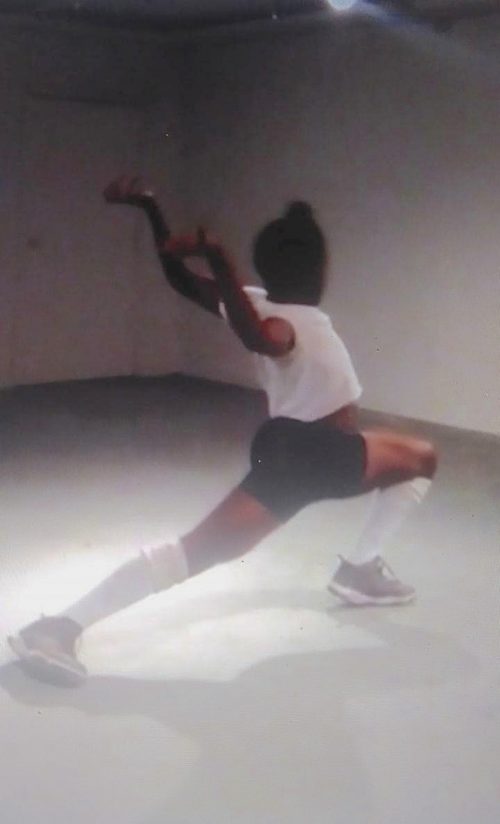
Whether he’s marrying the sensual with the cosmic, Vitche-Boul Ra has used dance to move through space and time like few artists can. His dance is intrinsically Black even when it challenges the notion of what Blackness is, of how we, the audience of all ethnicities, relate to that work. His upcoming collaborations with the aforementioned Icebox Project Space entitled Hotter Than July; I Just Might Burn You in August sees himself delving into the rare collaboration, this time with filmmaker Rush Jackson, inviting new vulnerabilities. Though we are certain to be dazzled by the multi-media, dreamlike quality of the work as the two, per their event description, transform the Icebox into “a space of Displacement, Recognition, Hots before Colds, and a pilgrimage point to negotiate the collective and individual composition”, Ra wants to keep things, at least in his view, simple. “I just want to know if we exist,” he insists, a question his movement strives to answer through the boundless canvas of the spaces he dances in.
See Vitche-Boul Ra in a performance/film collaboration with Rush Jackson, in “Hotter in July; I just may burn you in August,” Thursday, Aug. 8, 2019, 6-9 PM, Icebox Project Space, 1400 N. American St.
More Photos
